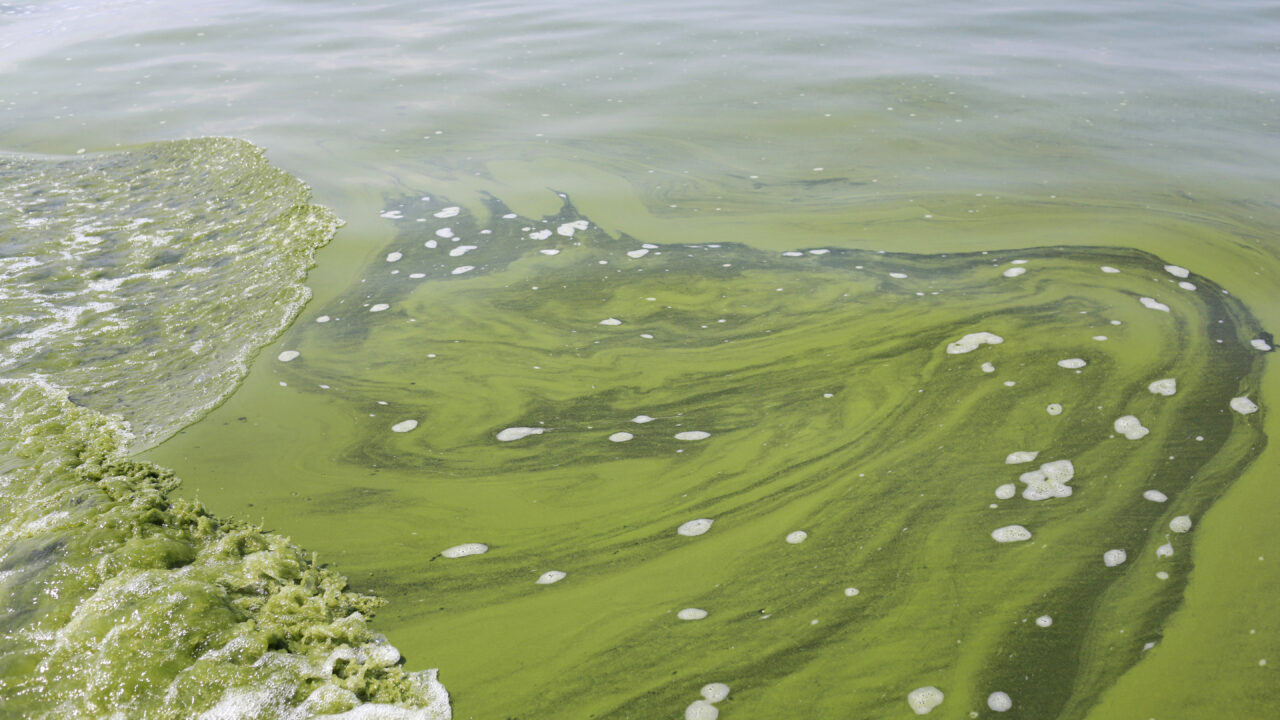A Reckoning for Our Phosphorous Binge
In his latest book, journalist Dan Egan shows how an essential component of life has become a global menace. An algae bloom covers Lake Erie near the City of Toledo. Photo: Haraz N. Ghanbari / AP.
An algae bloom covers Lake Erie near the City of Toledo. Photo: Haraz N. Ghanbari / AP.
This article was originally published on Undark. Read the original article.
One day about 10 years ago, a German beachcomber picked up a small orange rock and pocketed it without much thought. Minutes later, he looked down to see that his left leg was on fire. The rock, it turned out, was not a rock at all but a glob of phosphorus—a remnant of the deadly firebombs that pummeled the country during World War II. After decades of slumber, the modest heat of the man’s body had rekindled its wrath, leaving him badly injured.
That harrowing incident makes a fitting opener for Dan Egan’s new book, “The Devil’s Element: Phosphorus and a World Out of Balance.” In the tradition of environmental clarion calls like “Silent Spring” and “The Sixth Extinction,” which drew attention to the problems of pesticide overuse and disappearing species, respectively, “The Devil’s Element” urges readers to confront another quietly unfolding disaster. This one revolves around phosphorus—which is essential for life but has, at the hands of humans, become a menace in ways that go far beyond incendiary pebbles.
Phosphorus, which means “bringer of light,” earned its fiendish nickname in the 1600s, after a German alchemist cooked down urine to isolate the pure form of the element: a strange, glowing substance with a habit of bursting into flame. In many other chemical configurations, however, phosphorus is anything but dangerous. It is the backbone of DNA and a critical ingredient in the structure and function of cells, as well as hard body parts like bones and teeth. Humans need it to live—and to produce the crops that sustain us. Phosphorus is one of three key plant nutrients, and its looming scarcity may one day limit global food production.
By unlocking so much phosphorus that would have otherwise remained bound up in rocks, we’ve flooded the environment with surplus nutrients.
In nature, phosphorus cycles through ecosystems in a mostly closed loop as organisms live, die, and decay, making it “the elemental link that completes the circle of life,” writes Egan, an environmental journalist and the author of “The Death and Life of the Great Lakes.” Likewise, for millennia, many human societies recycled phosphorus by fertilizing crops with animal and human waste.
But that changed during the Industrial Revolution, when population growth and urbanization turned sewage from a resource to a scourge. In London, after unmanaged human waste caused the infamous cholera outbreak of 1854 (which launched the field of epidemiology) and the “Great Stink” of 1858 (when the already putrid River Thames turned exceptionally rank), city leaders created a sanitation system to dispose of excrement. That solved the immediate crisis but spawned a new one. “Shunting human waste into waterways in this manner permanently cracked the phosphorus circle,” Egan writes, creating a need for new sources of phosphorus and putting “the Western world on a path to chemical fertilizer addiction.”
We’ve fed this addiction by extracting more and more phosphorus-rich rock from the Earth to sprinkle on crops, and to make bombs, poisons, detergents, and batteries. Phosphate mining has allowed food production to keep pace with the world’s growing population. But it has come at a high price for anyone unlucky enough to live on top of these deposits.
Among many abuses, Egan recounts the cruel fate of that befell the inhabitants of a remote Pacific island who were swindled out of geologic riches before being displaced from their home entirely. And the world’s lust for phosphorus now fuels the occupation of Western Sahara by Morocco, which controls roughly three-quarters of all known reserves of rock phosphate. Egan, pulling no punches, calls the conveyor belt that carries mined phosphorus out of the disputed territory against the will of the Indigenous Sahrawi people “one of the world’s largest active crime scenes.”
Ultimately, he writes, our addiction to mined phosphorus will “likely pose a problem for every person on the planet, either in the pocketbook or in the stomach.” Rock phosphate is a stubbornly non-renewable resource and leading producers like the U.S. and China are voraciously consuming their stores. Researchers estimate that accessible deposits may run out within a few centuries—perhaps even a few decades—and many agree that, if nothing changes, the world’s ability to eat could eventually rest on Morocco’s willingness to share its bounty.
Farm runoff contains high levels of nutrients from fertilizer and animal manure, and scientists have documented increasing incidence of algae blooms in lakes around the world.
But what really makes phosphorus diabolical, Egan writes, is that we don’t just face a problem of shortage. We also face a crisis of excess. By unlocking so much phosphorus that would have otherwise remained bound up in rocks, we’ve flooded the environment with surplus nutrients. And once phosphorus leaks into rivers and lakes, it fertilizes “bumper crops” of algae that turn the water gloopy and green, then suck up oxygen when they die, leaving fish and other aquatic life gasping for breath.
Algae blooms are not a new problem. Dumping waste into waterways set the stage for trouble, and as Egan recounts in one of the most engaging sections of the book, the problem exploded in the 1950s and 60s after American companies developed newfangled laundry detergents that contained up to 74 percent phosphorus by weight. Soon, the country’s waterways were filled with bubbles and slicks of algae. Lake Erie became so famous for its phosphorus woes, Egan notes, that Dr. Seuss mentioned it in his environmental parable, “The Lorax.” As the greedy Once-ler defiles a vibrant paradise to make a quick fortune selling Thneeds, the Lorax sends away sad-eyed humming-fish in search of some water that “isn’t so smeary,” adding “I hear things are just as bad up in Lake Erie.”
Egan, a two-time Pulitzer Prize finalist for his work chronicling the threats facing the Great Lakes, has a knack for telling big, unwieldy stories through absorbing personal narratives, including the quest of one determined scientist to expose the role of phosphorus in driving 20th-century algae blooms. His work helped pressure detergent manufacturers to change their formulas, and by 1986 conditions in Lake Erie had improved enough that Dr. Seuss agreed to remove the Lorax’s quip from future editions of the book.
But the problem is back, Egan reports, and more pernicious and pervasive than ever. This time, a major culprit is industrial agriculture. Farm runoff contains high levels of nutrients from fertilizer and animal manure, and scientists have documented increasing incidence of algae blooms in lakes around the world. In Egan’s native Midwest, vast areas of Lake Erie have again turned “smeary,” fed by pollution from corn, soy, and livestock operations. At the same time, fertilizer coursing down the Mississippi River fuels massive blooms in the Gulf of Mexico, and stinking mats of algae in Florida clog the canals of ritzy subdivisions and foul tourist beaches.
The phosphorus crisis is fundamentally the product of converging human impacts.
Worst of all, the algae (or more precisely, cyanobacteria) that abound today are more likely to release toxins that kill animals, make drinking water unsafe, and contribute to a range of human ailments, including respiratory symptoms and perhaps even the devastating neurodegenerative disease ALS.
Throughout “The Devil’s Element,” Egan pinpoints the tipping points that prompted society to address earlier environmental crises, but argues that many barriers stand in the way of improving how we manage phosphorus today. Namely, the political and economic forces behind agricultural intensification and a toothless regulatory system that has failed to control the industry’s pollution.
Egan points out that solutions do exist. Water quality rules could be expanded to include farm runoff and technologies could be deployed to recycle phosphorus from human and animal waste. (The latter is already happening in places like Germany.)
But he acknowledges that the phosphorus crisis—like pesticide use, biodiversity loss, and other modern maladies—is fundamentally the product of converging human impacts. At the same time that humans have doused the world in phosphorus, widespread land use changes have reduced the ability of soil to absorb runoff while dams and dikes have altered the natural flow of water. On top of that, a warming climate has intensified rainfall and supercharged algae growth, while invasive species have aided the spread of toxic algae.
The end result, Egan concludes, is a calamity that doesn’t just threaten the environment but threatens us too. As he sums it up bluntly: “Abuse the Earth, and the Earth will abuse you.”

Independent journalism is under threat and overshadowed by heavily funded mainstream media.
You can help level the playing field. Become a member.
Your tax-deductible contribution keeps us digging beneath the headlines to give you thought-provoking, investigative reporting and analysis that unearths what's really happening- without compromise.
Give today to support our courageous, independent journalists.






You need to be a supporter to comment.
There are currently no responses to this article.
Be the first to respond.